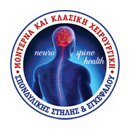
Craniosynostosis
Craniosynostosis is the premature fusion of the sutures of the baby’s skull. It is caused by a relatively rare skull (that is the bone cavity that surrounds the brain) formation disorder. It can be about one single suture (simple craniosynostosis as a congenital anomaly) or about multiple sutures (complex craniosynostosis caused by a genetic syndrome, such as the Crouzon* syndrome, the Apert** syndrome, etc.). When the premature fusion of the sutures is caused by another known disease, such as microcephaly or hyperthyroidism, then it is called secondary craniosynostosis. However, in most cases, the cause is unknown (primary craniosynostosis).
The main sutures of the skull are the coronal, the sagittal, and the lambdoid sutures that are normally fused by the 30th year of the person, and also the metopic suture that is normally fused by the 2nd year of the child. The coronal suture is fused prematurely more often (1 case per 4,000 births) in comparison with the other sutures, while the lambdoid suture is prematurely fused more rarely (3 cases per 100,000 births). Depending on the prematurely fused suture, the cranial malformation varies. Simple craniosynostosis of the coronal suture results in scaphocephaly (macrocephaly or dolichocephaly) while the bilateral coronal craniosynostosis results in brachycephaly. The unilateral coronal craniosynostosis results in anterior plagiocephaly, while the unilateral lambdoid craniosynostosis results in posterior plagiocephaly. The premature metopic synostosis results in trigonocephaly, which is more prevalent in boys. Finally, the premature craniosynostosis of all the sutures results in oxycephaly (conical head) that causes the decreased development of the skull (microcephaly) as well as the increase of the intracranial pressure and the increased risk of intellectual disability.
Treatment:
When increased intracranial pressure is observed, surgical treatment is required in order to prevent any intellectual disability. This phenomenon is common in complex craniosynostosis and the respective syndromes. On the other hand, in simple craniosynostosis, intracranial hypertension is rarely observed. The main indication for surgical treatment of the craniosynostosis is the cosmetic restoration of a skull malformation.
The surgical method that is applied in the simple craniosynostosis treatment is called cranioplasty and consists of the suture removal with a lip coating of factors that delay the bone creation aiming at the prevention of the craniosynostosis recurrence. Cranioplasty is usually applied before the sixth month of age. Complex craniosynostosis and craniosynostosis syndrome usually require more specialized surgical operations (bilateral craniotomy, orbital floor, or upper jaw restoration, etc.) that are applied in specialized centers.
*Crouzon Syndrome: Facial hypoplasia, narrow optic canals, proptosis, hypertelorism, strabismus
**Apert Syndrome: Facial dysplasia, hypertelorism, syndactyly on upper and lower limbs






